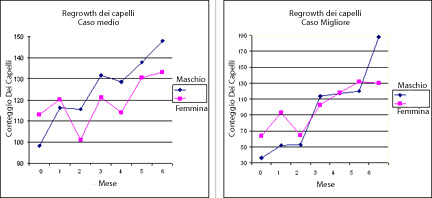|
||

|
||||
Gli studi clinici sono stati condotti secondo un Protocollo indipendente stabilito da una Commissione di Recensione presso un centro di ricerca avanzata per qualificare e quantificare l’efficacia del LaserComb come dispositivo medico per il trattamento dell’alopecia (perdita di capelli).
Sono stati inclusi nello studio sia pazienti maschi sia
femmine, di età compresa tra i 26 ed i 76 anni e sono stati valutati in un
periodo di sei mesi. I partecipanti allo studio dovevano avere capelli
assottigliati e presentare una perdita di capelli in fase attiva al momento
dell’inclusione nello studio. L’analisi è stata condotta in due sedi, sul cuoio
capelluto e sulle aree temporali e del vertice del capo.
Prima dell’inizio del trattamento con il LaserComb, ciascuna area è stata
isolata ed è stata scattata una foto ad alta risoluzione della zona in
questione.
Queste fotografie sono state caricate su un sistema d’immagini che identificava il corpo di ciascun capello.
Dopo l’ingrandimento è stata condotta una conta standard dei capelli ed il numero ottenuto è stato registrato per il confronto nelle fasi successive dello studio.
Dopo la prima demarcazione e la prima conta, a ciascun
paziente veniva fornito un HairMax LaserComb. I pazienti ricevevano istruzioni
per un utilizzo di due volte a settimana per un tempo stabilito di circa 10
minuti, coprendo tutto il capo due volte con ciascun trattamento.
Ogni mese; il paziente tornava alla clinica per isolare nuovamente le aree di
studio, fotografarle nuovamente e per registrare la conta dei capelli.
Al termine del periodo di 6 mesi, 97.4% dei pazienti arruolati nello studio
mostravano di aver tratto beneficio dall’impiego dell’HairMax LaserComb.
In oltre 84.2% dei pazienti inclusi nello studio
mostravano una rilevante ricrescita con un incremento medio della conta per
l’insieme dei pazienti maggiore del 45%. Questi numeri sono significativamente
migliori di quelli di qualsiasi altro prodotto testato fino ad oggi per la
ricrescita dei capelli.

Beneficio: Il beneficio al trattamento è
stato come definito la mancanza di perdita di capelli, > 0% Cambiare dalla linea
base nei capelli conta. La Crescita di capelli: Il beneficio è stato definito
come mancata perdita di capelli o una variazione > 11% dalla conta iniziale.
Valore statistico: Tutti i valori-p per questo studio erano rilevanti. Il
valore-p (ovvero la probabilità che una variabile potesse assumere un valore
superiore o uguale a quelle del valore osservato) in fine di questo studio
(<0.0001) indica che i risultati di questo studio avrebbero un’elevatissima
probabilità d’essere validi anche sulla popolazione generale. In altre parole,
nella popolazione generale d’uomini e di donne che presentano perdita di
capelli, si potrebbe, con ogni probabilità, osservare gli stessi incrementi
nella conta che sono stati osservati nei pazienti inclusi in questo studio.
I risultati dei pazienti variavano da persona a persona.
Per esempio, un partecipante di 61 anni ha presentato un aumento da 34 a 94 capelli per centimetro quadro, un incremento del 161%.
L’esperienza nell’utilizzo costante indica che la ricrescita continua anche dopo sei mesi.
La riduzione della conta dei capelli nelle
fasi precoci del trattamento è indicativo di una perdita durante la fase
telogena che è indotta dai nuovi capelli che crescono e che spingono via i
capelli vecchi e maturi.
Conclusioni dello studio
Questo studio ha definitivamente dimostrato che l’HairMax LaserComb è un metodo
efficace per combattere la perdita di capelli.
L’incremento medio consistente della conta dei capelli dimostra che il LaserComb non solo controlla l’eccessiva perdita di capelli che conduce alla calvizie ma che i capelli vengono stimolati a crescere nuovamente secondo parametri normali e sani.
Il LaserComb ha inoltre dimostrato la sua efficacia sia negli uomini sia nelle donne di tutte le età.